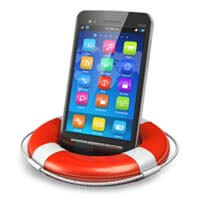
Regardless of your location, the summer months are usually the prime part of the year for natural disasters. One of the best and most affordable things we can do to see ourselves through a disaster is to be prepared and one great way is through the use of apps on our phones and devices.
Both Android and Apple mobile devices offer a wide variety of apps that users rely on daily. Because of this, these devices have become an integral part of our lives and would no doubt be on hand if disaster struck. The upside to this is that there are apps that can help you and your family as well as work associates whatever the disaster. Here are three of the best types of disaster related apps out there in order to prepare.
Weather Apps
It is always a good idea to know what the weather forecast is for your local area. This can help you predict what could happen and even prepare your business should say a big storm be rolling in. There are a wide variety of weather apps out there and it can be difficult to actually pick which is the best to use. Here are a few to look at first:
- The NOAA Weather Radio – Available on iTunes for iPhone and iPad users, this app is the official app for the National Oceanic and Atmospheric Association. When installed, you can receive local weather forecasts based on your location and storm or severe weather warnings pushed directly to your device. The app can be found on iTunes and costs just a few dollars.
- Weather Underground – This app is among the most powerful weather apps out there. Using a wide variety of weather stations and user submitted weather it is up to date and able to offer accurate forecasts. With a Weather Radio feature, and push notifications of weather alerts, you can easily track potential storms. There is also the WunderMap which has radar, reports and IR Sat views as well. The app is available for free on Google Play and iTunes.
- Local Weather Apps – Many TV stations and weather organizations have localized weather apps that focus on just local conditions. If you live in a severe weather prone area, it would be a good idea to see if your local TV station has a weather app, as this could be the quickest way to receive relevant updates.
Red Cross Apps
The Red Cross has a number of excellent survival oriented apps that could really come in handy for when a disaster strikes. These apps provide tips on how to prepare yourself and your family, as well as buildings for disaster, and what to do during and after a disaster strikes.
The best part is that most of the information is available offline, so you will have access to it even if cell networks are down. Some of the apps even provide weather alerts that will sound even if the app isn’t open, alerting you about any impending danger.
These apps are all available for free on Google Play and iTunes. The best thing to do is to visit the Red Cross website and look for the apps that are relevant to your local area e.g., if you are in the mountains the Forest Fire and First Aid apps may help. The apps are all free and can be downloaded by clicking the links for your device’s app store on the Red Cross site.
Social Media Apps
Social media services could prove to be a good way to connect and communicate during a disaster. One of the biggest added advantages to using social networks is that the servers that host the service are located around the world, so the chances of the service being down is fairly slim. If you have Internet access, you will be able to access the service.
A few simple tips to help you leverage your mobile device during a disaster
- Install relevant apps – In order to be prepared, you should install the apps necessary to communicate during a disaster, along with a weather app and if necessary a survival app.
- Ensure your contacts are up to date – To be sure, you should periodically update your contacts. Should anything happen you will know how to contact people and have a higher chance of being able to get in touch.
- Establish procedures to follow during a disaster – This is arguably the most important preparation you can do. Take the time to establish procedures you and your family should follow during an emergency. Include where people should meet, backup plans, contact suggestions and the roles you expect your everyone to take.
- Keep your batteries topped up – Mobile devices rely on batteries to operate, and during a disaster you may be without a power source for an extended amount of time. Therefore, Minimize use during a disaster. Ensure your batteries are full, or charges as often and has high as possible.
- Invest in a good power bank – Power banks are useful tools that are essentially big batteries. You can charge them up then use them to charge your devices. Take a look for one that is at least 9000 MHZ, or higher. The higher the number the bigger the charge.